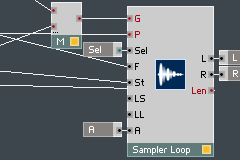 This post follows on from a previous post about Event Table and Iteration modules. Towards the end of that post, I was imagining using an event table with several rows of data; using Row 0 (the first row) to control some parameter of my instrument, using Row 1 (second row) to control another parameter, Row 2 (third row) to control a third parameter...
This post follows on from a previous post about Event Table and Iteration modules. Towards the end of that post, I was imagining using an event table with several rows of data; using Row 0 (the first row) to control some parameter of my instrument, using Row 1 (second row) to control another parameter, Row 2 (third row) to control a third parameter...And someone on the Reaktor forum called my bluff and asked me to show how to do that. This week, I suddenly thought of how I might do it, so this post is an attempt to implement that technique:
Watch the video
I'm not actually making any noises this time (the last episode got a bit spooky, so I'm giving the atmospheric sonics a rest), I thought I'd test my theory with an ultra-simple instrument that simply sends the event table's outputs to a number of numeric readout panel controls. I actually found this simplification really useful: it meant I was able to see the results of my work as numbers, rather than having to interpret the numbers' effects on a sound. The video might also be useful to anyone looking to start processing and controlling events with iteration, value and order modules.
Note: I've been testing Azureus Vuze as a platform for my videos and I've discovered that I don't like it very much. This time, I'm testing a website called Sclipo, which has ropier sound but gives you a handy full-screen feature (right-hand side of the video control panel), looks more like Youtube than Azureus does, and where you can also learn how to play "Roses" by Outkast on piano or electronic keyboard. Sweet mother of the baby Jesus.






